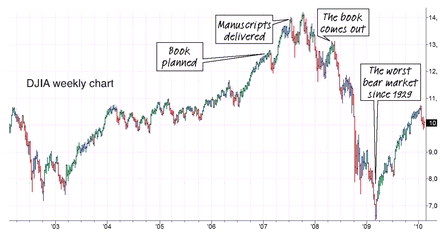PART FOUR
LESSONS OF THE BEAR MARKET
Rising stock prices are good for expense accounts. In February 2007, as the great bull market was charging towards its final peak, my publisher invited me and two friends to dinner at an expensive restaurant in New York City.
In those happy days, my research kept warning that the bull was running out of breath. I told my publisher that the area least covered in trading literature was selling. He liked the idea and urged me to write Sell and Sell Short.
I promised to deliver the manuscript before the end of the year; it would take the publishing house a few more months to produce the book. I told my publisher that by then I expected the bull market to be finished—we would be releasing the book into a bear market.
Markets often overshoot their targets, both on the way up and on the way down. The 2007-2009 bear market has turned out to be unusually severe—but its final wash-out in March 2009 created bargains of the century.
Writing a Bear Book during a Bull Market
Traders who survived this bear market learned the importance of planning when and where to sell. Many more have become interested in shorting. This is what the pros have been doing all along—the quick money tends to be on the short side of the markets.
In February 2010, my publisher called to suggest updating Sell and Sell Short. We discussed the project over the phone—there ...


